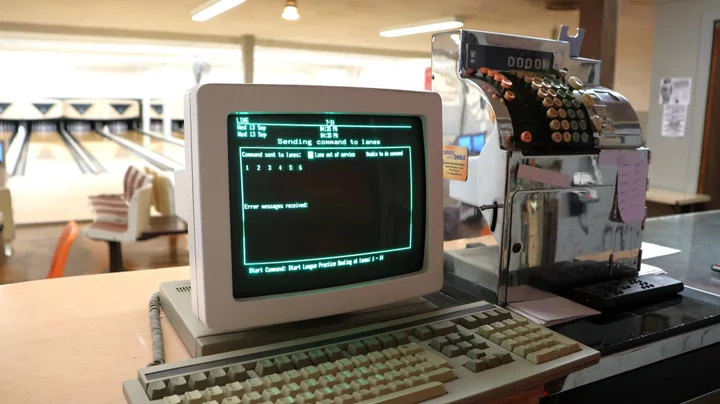The Fireside Bowl in Chicago might be one of the last truly retro bowling alleys in America. While newer alleys may keep the same look—with vintage color palettes and leagues donning two-tone collared shirts—Fireside's commitment to the good old days runs deeper than most.
Fireside Bowl from the street. (Credit: Emily Dreibelbis)Fireside keeps track of bowlers' scores with a vintage system called AccuScore Plus. When it debuted in the 80s, AccuScore was one of the first systems with predictive, automated scoring. It originally cost $300,000 and this "high-technology bowling" confused some players at first, The New York Times wrote in 1988.
These days, bowlers have a better handle on it. "It's just like the old days," says Julio Gonzalez, manager at Fireside Bowl. "It's all commands. So, I press 'S' for start and 'L' for league [mode], then the lanes that I want to open. Pretty cool.”
(Credit: Emily Dreibelbis)From Nuclear Reactors to Bowling Tech
AccuScore is a priceless time capsule—both of America's bowling heyday and its controversial creator: American Machine and Foundry.
The company (later rebranded to AMF) was founded in 1900 in New Jersey by Rufus L. Patterson, the inventor of the first automated cigarette manufacturing machine. AMF went on to make an array of products, from pretzel benders to tennis rackets. It even owned Harley Davidson from 1969 to 1981.
AMF's bowling legacy mostly began after World War II. Its 1946 debut of the patented Pinspotter, the first automated pin-setting machine, revolutionized the bowling industry. "Prior to its availability, all pins had to be reset by hand, with stereotypically surly and unkempt teenage boys, the usual workers, earning five to 10 cents a game," according to Encylopedia.com.
Bowling lanes at Fireside Bowl (Credit: Emily Dreibelbis)In the late 1950s, AMF's business took a more serious turn. Patterson recruited a US Army general to be its vice chairman: Walter Bedell Smith. Nicknamed "Beetle," Smith later went on to be President Eisenhower's wartime chief-of-staff, President Truman's ambassador to the Soviet Union, and the director of the CIA.
Under Smith, the company quietly began developing military equipment—while continuing to produce a smattering of other items such as model airplanes, snow skis, and garden equipment—using a vast network of 42 manufacturing plants.
Emblematic of the "military-industry complex," as Eisenhower would later call it, AMF began cranking out launching silos for intercontinental ballistic missiles (ICBMs) and launching systems for the Minuteman missile. It built nuclear reactors for Pakistan and Iran under Eisenhower's Atoms for Peace program.
At the same time, Americans were falling deeper in love with bowling. While the sport had been played casually for years, the American Bowling Congress (formed in 1895) was the first to create standard, nationalized rules. It held America's first national tournament in 1901—coincidentally in Chicago. By the 1960s, professional bowlers made "twice as much money as NFL stars, signed million-dollar contracts, and were heralded as international celebrities," writes Priceonomics.
Bowling shoes at Fireside Bowl (Credit: Emily Dreibelbis)Seizing the opportunity, AMF set aside its missile launchers and nuclear reactors and went into bowling tech. AMF's first automated scoring software debuted around 1980 (the history is hard to pin down, pun intended). "No more pencils for keeping score, computer does it," wrote the New York Sunday Democrat and Chronicle in a 1982 profile of an alley that had installed one of AccuScore's predecessors.
The business had a shorter-than-expected runway, however, as bowling's popularity began to decline in the 1980s as other sports captured Americans' interest. AMF also began to lose control of its sprawling enterprise, leading to an acquisition via hostile takeover in 1985. The company was kaput, but its legacy lived on through a spinoff company: AMF Bowling (1986), which introduced AccuScore Plus, the software used at Fireside Bowl, in 1987.
'We Keep it Retro'
“All of the AMF people are either dead or retired," says Gonzalez. He operates the system from the front desk, using a green-and-black WYSE monitor to control the lanes. If the system breaks down, Gonzalez does all the troubleshooting himself.
It generally works well, he says. After activating the lanes on the monitor, Gonzalez flicks an original, 1960s wall switch to turn on the pin-setters and ball retrieval mechanism. The patrons are then ready to use the colorful buttons on the keypad to enter their names (first initial only) and start bowling.
Fireside Bowl scoring system (Credit: Emily Dreibelbis) Fireside Bowl lane activator (Credit: Emily Dreibelbis)Fireside Bowl didn't always use AccuScore Plus. The alley's owner, the Lapinski family, installed it in 2004. It was part of a larger renovation, as the building had fallen into disrepair and emerged as a haven of Chicago's punk rock music scene, WBEZ reports.
“We could’ve put modern equipment in, but we didn’t want that," says Gonzalez. "We keep it retro.”
Commitment to the old style has paid off. Fireside has served as the set of major films and TV shows: Rapid Fire (1992) featuring Brandon Lee and Powers Boothe; The Break-Up (2006) featuring Vince Vaughn and Jennifer Anniston; an episode of The Chicago Code (2011); an episode in Chicago Fire (2015); the film Widows (2018); and most recently an episode of Chicago PD (2021).
The band Alkaline Trio paid tribute to Fireside's music roots in the song "Goodbye Forever" (2000). The line says, "Somehow the singer showed Fireside exactly how I feel."
(Credit: Emily Dreibelbis) (Credit: Emily Dreibelbis)Later this year, Fireside will switch from AMF's AccuScore Plus to another retro system called Purrfect Desk. "It's a little bit more modern," Gonzalez says as he displays a photo of the manual he's reviewing. By "modern" he means perhaps late 1990s—certainly not 2023 tech. While we were unable to confirm when Purrfect Desk came out, it appears old enough to have the simplistic graphics and bold colors of years past.
"I know this is a really, really long shot, but are there any centers out there still using the PurrfectDesk software?" writes one Reddit user. The answer is, "yes," you will soon find it at the Fireside Bowl—relegating AMF's AccuScore Plus to the archives.
(Credit: Emily Dreibelbis)An hour at Fireside costs $30 per hour on the weekdays, and $50 on the weekends. The alley takes payment on a more modern computer, which accepts credit card and is housed behind the front desk.
With vintage posters, old bowling trophies, and a well-kept pool table, Fireside's bar might be the perfect spot to relax after the game and chat about a bit of unexpected history.
Julio Gonzalez (Credit: Emily Dreibelbis)








